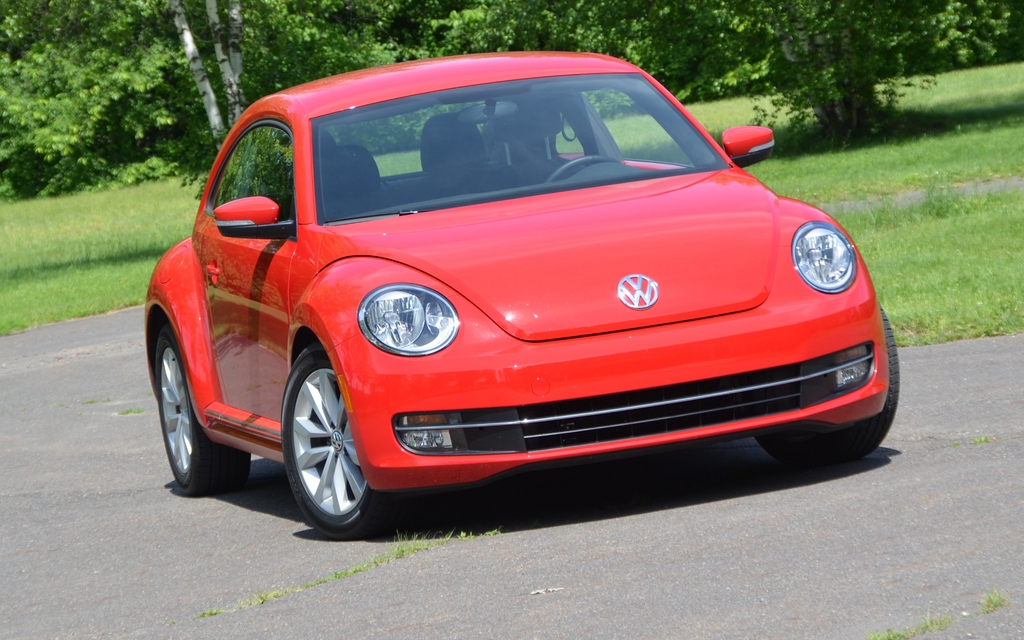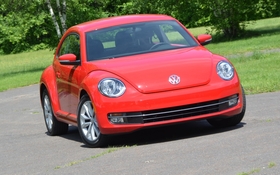2012 Volkswagen Beetle: Just serious enough

| Strong points |
|
|---|---|
| Weak points |
|
For a team of automobile designers, redesigning an immensely popular car is an incredibly difficult exercise. One misstep, whether you’re too bold or not bold enough, and it could be the beginning of the end for the model.
In the case of the New Beetle, although it wasn’t as popular as it used to be, the task was no less arduous. How do you redesign the lines of such a classic and timeless car? There was no shortage of people, myself included, who believed that the original Beetle and its second generation – the New Beetle – were done for. The thinking was that the designers would never manage to breathe new life into a model put on the market solely for its legacy.
And boy, was I ever wrong! The Beetle (it’s no longer the New Beetle, since you can’t be new twice in a row) launched in July 2011 and has the same curves as the one it’s replacing but they have been modified to reflect today’s tastes. It’s longer and wider than its predecessor and the roof is flatter, which changes the proportions somewhat. Overall, it’s less cartoonish and it seems more solid on the road, which adds to its credibility.
Modern dashboard and a nod to the past
The passenger compartment is more serious than it used to be. The dashboard respects the Beetle’s history, but it’s resolutely modern and infinitely less austere than most other Volkswagen dashboards. Its large gauges are easily to read and you can find your way around the menus of the central touch screen with relative simplicity. Most of the plastics are well crafted, although some are still a bit hard to the touch. On the other hand, they don’t scratch easily. On the right, there’s a supplementary glove compartment in the upper part of the dashboard, as there was in the first Beetle (known to purists as the only Beetle). The flower pot is indeed gone, which some of my colleagues believe confirms that the current Beetle is targeting men more than women. Pure hogwash.
Unlike the two hard-to-access backseats that offer good headroom but lousy legroom, the front seats are very comfortable. And the back windows don’t roll down. The trunk is bigger than before but the Fender edition’s big subwoofer encroaches on the cargo space. At least the sound of the audio system is excellent. Three-quarter visibility isn’t the Beetle’s best quality, but it’s better than you’d think.
Jetta anyone?
While the previous generation, which appeared in 1999, was based on a Golf chassis, the most recent Beetle is based on a shorter version of the Jetta platform. Mechanically speaking, the engineers used the same engines as for the Jetta, namely a 2.5-litre four-cylinder featuring 170 horses. This engine manages quite well, even though performance isn’t exceptional. A six-speed automatic transmission transmits torque to the front wheels but, although it isn’t a twin-clutch, it handles very well. A five-speed manual is also available. During our weeklong test drive, our Beetle’s fuel consumption was a very high 10.7 L/100 km, calculated by hand. The on-board computer’s average fuel consumption reset itself to zero every departure. 10.7 L/100 km is a lot more than the 9.5 in town promised by Volkswagen (7.1 on the highway).
Driving enthusiasts will be a lot happier with the Turbo version. Its 2.0-litre engine, taken from the Jetta GLI, joyfully propels the Beetle with the help of its ever-motivated 200 horses. VW had the great idea of pairing the engine with the six-speed twin-clutch automatic transmission, or you can opt for the six-speed manual. Moreover, fuel consumption isn’t higher than with the 2.5-litre. A TDI version will soon be unveiled.
On the road, the Beetle’s Jetta origins are obvious. Even the base version, with its rear torsion-bar suspension and its rear drum brakes, grips the road tenaciously. There’s practically no roll, the steering is precise and communicative and the seats are very supportive in turns: a perfect mix for fans of sport driving. The traction control intervenes only when necessary, which is a good thing since it can’t be deactivated. The brakes, even with drums, are efficient and stop the car in 44 metres, which won’t break any records but isn’t too shabby either. On the other hand, I have my doubts about how resistant they’ll be with intensive use.
A two-door Jetta?
Of course, the Turbo version is even more fun to drive, as long as you’re willing to pay the price. While the Comfortline base version (2.5 litres) starts at $21,975, they’re asking $29,000 for a Sportline with a 2.0-litre turbo. That’s a little pricy for a more stylish but less practical Jetta. At that price, I’d opt for a Jetta GLI. But then again, I’m a 51-year old man who’s way too serious.











